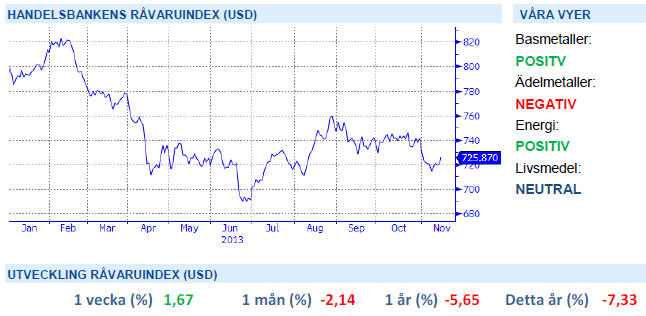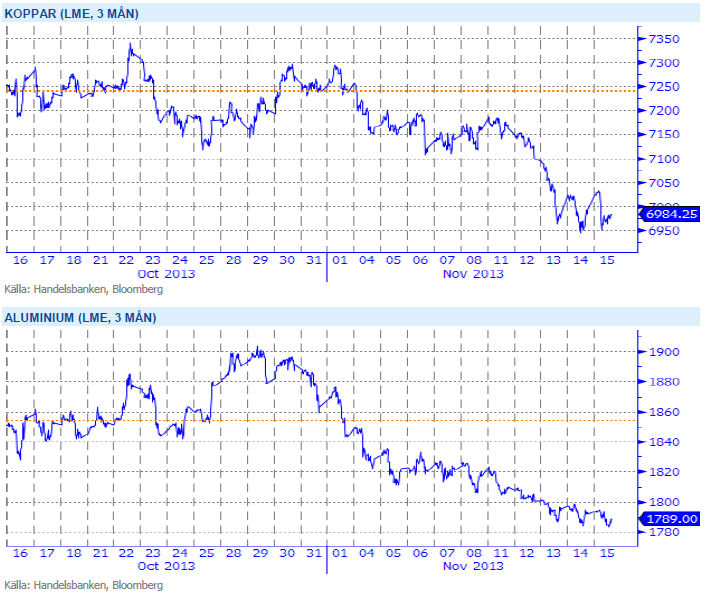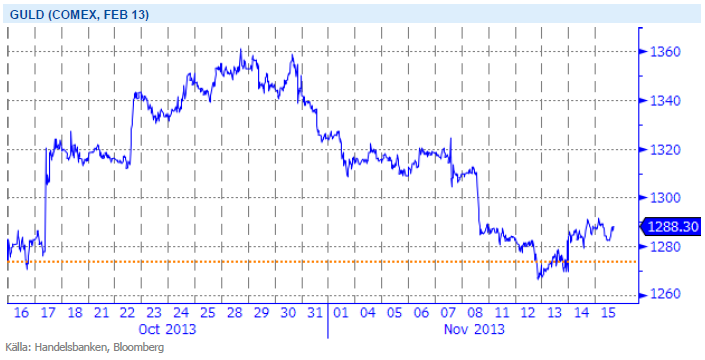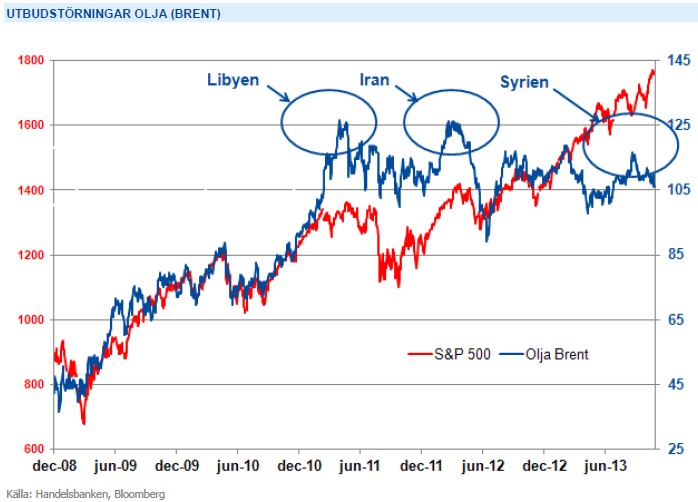Analys
SHB Råvarubrevet 15 november 2013

 Råvaror allmänt
Råvaror allmänt
Ökad sysselsättning i USA
Positiv data i form av Amerikansk sysselsättning gav stöd åt råvarumarknaden. Sysselsättningen för oktober steg kraftigt och sysselsättningen för september reviderades upp. Med tanke på nedstängningen av en del statliga myndigheter och de svårigheter som då uppstod var utfallet klart över förväntan. Det starka utfallet ökar på marginalen sannolikheten för att Federal Reserve påbörjar nedskalningen av obligationsköp och vilket fart på globala långräntor. Å andra sidan, med anledning av nedstängningen är oktoberdata svårtolkad, inte minst då statistiska undersökningar inte kunnat utföras enligt normala rutiner. Så det är inte helt självklart att sysselsättning förblir över 200 000 framöver.
Janet Yellen kommer med största sannolikhet att efterträda Fedchefen Ben Bernanke när hans mandatperiod tar slut den 31 januari. Yellen är en stark anhängare av kvantitativa lättnader (obligationsköp) och veckans utfrågning i Senaten var ett kvitto på att Fed lär fortsätta på inslagen linje under hennes ledning. Det bidrog till ökad riskaptit då investerare tolkade det som att en minskning av tillgångsköpen inte ligger runt hörnet ännu.
Utfallet från strategimötet i Kina som påbörjades förra fredagen har ännu inte publicerats. Tillväxtstarka uttalande kommer ge råvaror en fortsatt skjuts uppåt och vi ser speciellt basmetaller som köpvärda.
Basmetaller
Fallande priser för metallerna
Handelsbankens basmetallindex faller drygt 1 % under veckan. Yellens uttalande vid nomineringsutfrågningen i torsdags tolkades som mjuka av marknaden då inga tydliga besked om tapering gavs. Detta skapade visserligen uppgångar men de stora metallerna koppar, aluminium, nickel och zink slutar veckan på minus. Koppar leder nedgången med nästan 3 procent, bland annat till följd av data som visar på fallande investeringar i kraftnätverk i Kina, som är ner 20% y-o-y. Koppar till bland annat kraftledningar står för 40 % av Kinas totala kopparkonsumtion.
LME meddelade förra veckan att de inför kortare leveranstider från börsens lager från och med 1 april 2014. Långa kötider har som bekant pressat upp fysikiska premier (med 100-200 procent över 10 årsnittet). Regleringen innebär förkortning av leveranstiden från 100 till 50 dagar. Trots fallande priser denna vecka tycker vi metallerna ser köpvärda ut. Visar ledarna i Kina på starka tillväxtmål gäller det att vara positionerad för en uppgång.
Vi tror att Kinas tillväxt kommer överraska positivt under Q4 och Q1, vilket kommer stärka metallerna. Vi tror på: LONG BASMETALLER
Ädelmetaller
Guldet fortsätter sin väg ned
En ganska händelsefattig vecka för guldet närmar sig sitt slut, och vi bibehåller vår negativa syn på ädelmetallsektorn. Guldet handlar nu 1.5 % lägre än förra veckan, och större delen av prisfallet inträffade vid förra fredagens starka arbetslöshetsstatistik från USA.
Den troliga utnämningen av Janet Yellen som Bernankes efterträdare vid Fed-rodret borde peka mot ytterligare stimulativ penningpolitik i USA (kvantitativa lättnader) och en förskjutning av tapering in i framtiden. Detta ska ställas mot förbättrad amerikansk ekonomisk statistik. Samtidigt ser bilden lite svagare ut i Europa igen efter ECB:s sänkning, och bilden för guldet är alltjämt oklar. Veckan som gått har sett ytterligare små utflöden ur guld-ETF:er, en trend som pågått ända sedan årsskiftet då guldet handlade strax under 1700 USD per uns. Investeringsflödena ger därmed inget stöd för någon teori om att guldets vändning uppåt skulle vara nära i antågande.
Efter en uppgång under sommaren tror vi åter att guldets väg lutar utför. Vi tror på: SHRT GULD H
Energi
Osäkerhet i Libyen stärker oljan
Oljemarknaden stiger närmare 3 procent under veckan med stöd från amerikansk sysselsättningsstatistik och den politiska oron i Libyen. Även om amerikanska lagersiffror fortsätter stiga mot förväntan tror vi att oljepriset kan komma att stiga något ytterligare, främst med tanke på osäkerheten i Libyens utbud och det ständigt återkommande säkerhetsfrågorna kring Iran vilket motiverar en liten riskpremie även om det fundamentalt ser något bättre än för några veckor sedan. Vi går mot vintertid vilket snabbt kan driva på oron kring en låg reservkapacitet så vi ligger fast med vår syn om att Brentoljan alltid är köpvärd ner mot nivåer om 104-105 dollar med potential på uppsidan.
Elmarknaden fortsätter att stiga med närmare 2 procent denna vecka som ett resultat av en något starkare Tysk marknad och utsikter om mer normalt väder från inledningen av nästa vecka samtidigt som energikolet som väntat finner stöd på dessa låga nivåer. Energibalansen visar på ett underskott om 18 TWh mot normalen och Forsmark 1 har gått halvt ur drift pga av dränageläckage så vår positiva syn på prisutvecklingen kvarstår.
Energiunderskott tillsammans med osäkerhet kring kärnkraftsverken inför vintern talar för högre elpris. Vi tror på: LONG EL
Livsmedel
Kaffepriset ned 66% sedan maj 2012
Terminspriset (marskontraktet) på Arabicakaffe i New York bröt genom 1.10 dollar/Ib nivån i slutet av oktober och har inte riktigt orkat ta sig upp igen sen dess. Kaffepriset har fallit 66 procent sedan maj 2011 och handlas idag på samma nivå som mars 2009. Den totala produktionen från de största kaffe-exportörerna för kaffeåret 2012/2013 uppskattas landa på rekordnivåer och likaså den totala exporten.
Det är naturligtvis för tidigt att göra en rättvis uppskattning av världsproduktionen för kaffeåret 2013/2014 och efter nästan tre raka år med fallande priser har vi ännu inte sett ett trendbrott. Men det som bl.a. talar för en uppsida är de låga priserna som kan komma att avskräcka kaffeodlarna från att vilja investera i kaffebönor. Även defekter från bladsvamp i Mexico och Centralamerika, som orsakade ett produktionsbortfall på 2.7 miljoner bags (1 bag=60 kg) 2012/2013, sägs ha en signifikant effekt på kommande skörd. Lägg därtill att världskonsumtionen väntas stiga med 2,4 procent i snitt årligen.
Försening av skörden efter längre perioder av nederbörd i Brasilien samt en stark brasiliansk real driver upp sockerpriset. Vi tror på: BULL SOCKER
Handelsbankens Råvaruindex
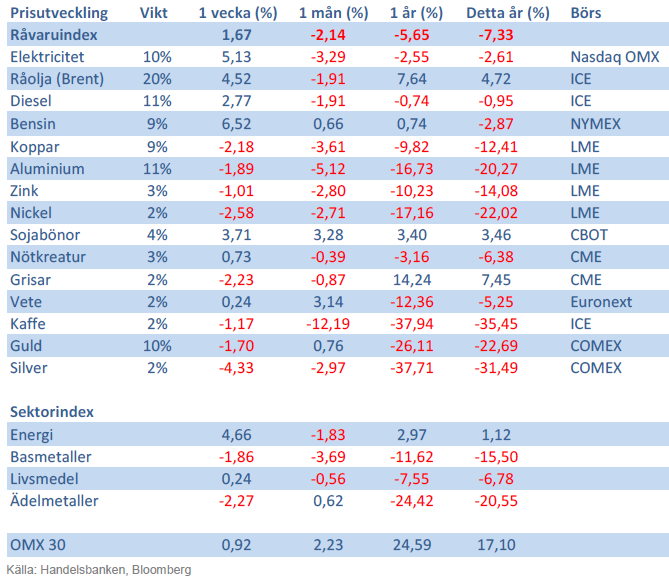
Handelsbankens råvaruindex består av de underliggande indexen för respektive råvara. Vikterna är bestämda till hälften från värdet av nordisk produktion (globala produktionen för sektorindex) och till hälften från likviditeten i terminskontrakten.
[box]SHB Råvarubrevet är producerat av Handelsbanken och publiceras i samarbete och med tillstånd på Råvarumarknaden.se[/box]
Ansvarsbegränsning
Detta material är producerat av Svenska Handelsbanken AB (publ) i fortsättningen kallad Handelsbanken. De som arbetar med innehållet är inte analytiker och materialet är inte oberoende investeringsanalys. Innehållet är uteslutande avsett för kunder i Sverige. Syftet är att ge en allmän information till Handelsbankens kunder och utgör inte ett personligt investeringsråd eller en personlig rekommendation. Informationen ska inte ensamt utgöra underlag för investeringsbeslut. Kunder bör inhämta råd från sina rådgivare och basera sina investeringsbeslut utifrån egen erfarenhet.
Informationen i materialet kan ändras och också avvika från de åsikter som uttrycks i oberoende investeringsanalyser från Handelsbanken. Informationen grundar sig på allmänt tillgänglig information och är hämtad från källor som bedöms som tillförlitliga, men riktigheten kan inte garanteras och informationen kan vara ofullständig eller nedkortad. Ingen del av förslaget får reproduceras eller distribueras till någon annan person utan att Handelsbanken dessförinnan lämnat sitt skriftliga medgivande. Handelsbanken ansvarar inte för att materialet används på ett sätt som strider mot förbudet mot vidarebefordran eller offentliggörs i strid med bankens regler.
Analys
Tightening fundamentals – bullish inventories from DOE

The latest weekly report from the US DOE showed a substantial drawdown across key petroleum categories, adding more upside potential to the fundamental picture.

Commercial crude inventories (excl. SPR) fell by 5.8 million barrels, bringing total inventories down to 415.1 million barrels. Now sitting 11% below the five-year seasonal norm and placed in the lowest 2015-2022 range (see picture below).
Product inventories also tightened further last week. Gasoline inventories declined by 2.1 million barrels, with reductions seen in both finished gasoline and blending components. Current gasoline levels are about 3% below the five-year average for this time of year.
Among products, the most notable move came in diesel, where inventories dropped by almost 4.1 million barrels, deepening the deficit to around 20% below seasonal norms – continuing to underscore the persistent supply tightness in diesel markets.
The only area of inventory growth was in propane/propylene, which posted a significant 5.1-million-barrel build and now stands 9% above the five-year average.
Total commercial petroleum inventories (crude plus refined products) declined by 4.2 million barrels on the week, reinforcing the overall tightening of US crude and products.


Analys
Bombs to ”ceasefire” in hours – Brent below $70

A classic case of “buy the rumor, sell the news” played out in oil markets, as Brent crude has dropped sharply – down nearly USD 10 per barrel since yesterday evening – following Iran’s retaliatory strike on a U.S. air base in Qatar. The immediate reaction was: “That was it?” The strike followed a carefully calibrated, non-escalatory playbook, avoiding direct threats to energy infrastructure or disruption of shipping through the Strait of Hormuz – thus calming worst-case fears.

After Monday morning’s sharp spike to USD 81.4 per barrel, triggered by the U.S. bombing of Iranian nuclear facilities, oil prices drifted sideways in anticipation of a potential Iranian response. That response came with advance warning and caused limited physical damage. Early this morning, both the U.S. President and Iranian state media announced a ceasefire, effectively placing a lid on the immediate conflict risk – at least for now.
As a result, Brent crude has now fallen by a total of USD 12 from Monday’s peak, currently trading around USD 69 per barrel.
Looking beyond geopolitics, the market will now shift its focus to the upcoming OPEC+ meeting in early July. Saudi Arabia’s decision to increase output earlier this year – despite falling prices – has drawn renewed attention considering recent developments. Some suggest this was a response to U.S. pressure to offset potential Iranian supply losses.
However, consensus is that the move was driven more by internal OPEC+ dynamics. After years of curbing production to support prices, Riyadh had grown frustrated with quota-busting by several members (notably Kazakhstan). With Saudi Arabia cutting up to 2 million barrels per day – roughly 2% of global supply – returns were diminishing, and the risk of losing market share was rising. The production increase is widely seen as an effort to reassert leadership and restore discipline within the group.
That said, the FT recently stated that, the Saudis remain wary of past missteps. In 2018, Riyadh ramped up output at Trump’s request ahead of Iran sanctions, only to see prices collapse when the U.S. granted broad waivers – triggering oversupply. Officials have reportedly made it clear they don’t intend to repeat that mistake.
The recent visit by President Trump to Saudi Arabia, which included agreements on AI, defense, and nuclear cooperation, suggests a broader strategic alignment. This has fueled speculation about a quiet “pump-for-politics” deal behind recent production moves.
Looking ahead, oil prices have now retraced the entire rally sparked by the June 13 Israel–Iran escalation. This retreat provides more political and policy space for both the U.S. and Saudi Arabia. Specifically, it makes it easier for Riyadh to scale back its three recent production hikes of 411,000 barrels each, potentially returning to more moderate increases of 137,000 barrels for August and September.
In short: with no major loss of Iranian supply to the market, OPEC+ – led by Saudi Arabia – no longer needs to compensate for a disruption that hasn’t materialized, especially not to please the U.S. at the cost of its own market strategy. As the Saudis themselves have signaled, they are unlikely to repeat previous mistakes.
Conclusion: With Brent now in the high USD 60s, buying oil looks fundamentally justified. The geopolitical premium has deflated, but tensions between Israel and Iran remain unresolved – and the risk of missteps and renewed escalation still lingers. In fact, even this morning, reports have emerged of renewed missile fire despite the declared “truce.” The path forward may be calmer – but it is far from stable.
Analys
A muted price reaction. Market looks relaxed, but it is still on edge waiting for what Iran will do

Brent crossed the 80-line this morning but quickly fell back assigning limited probability for Iran choosing to close the Strait of Hormuz. Brent traded in a range of USD 70.56 – 79.04/b last week as the market fluctuated between ”Iran wants a deal” and ”US is about to attack Iran”. At the end of the week though, Donald Trump managed to convince markets (and probably also Iran) that he would make a decision within two weeks. I.e. no imminent attack. Previously when when he has talked about ”making a decision within two weeks” he has often ended up doing nothing in the end. The oil market relaxed as a result and the week ended at USD 77.01/b which is just USD 6/b above the year to date average of USD 71/b.

Brent jumped to USD 81.4/b this morning, the highest since mid-January, but then quickly fell back to a current price of USD 78.2/b which is only up 1.5% versus the close on Friday. As such the market is pricing a fairly low probability that Iran will actually close the Strait of Hormuz. Probably because it will hurt Iranian oil exports as well as the global oil market.
It was however all smoke and mirrors. Deception. The US attacked Iran on Saturday. The attack involved 125 warplanes, submarines and surface warships and 14 bunker buster bombs were dropped on Iranian nuclear sites including Fordow, Natanz and Isfahan. In response the Iranian Parliament voted in support of closing the Strait of Hormuz where some 17 mb of crude and products is transported to the global market every day plus significant volumes of LNG. This is however merely an advise to the Supreme leader Ayatollah Ali Khamenei and the Supreme National Security Council which sits with the final and actual decision.
No supply of oil is lost yet. It is about the risk of Iran closing the Strait of Hormuz or not. So far not a single drop of oil supply has been lost to the global market. The price at the moment is all about the assessed risk of loss of supply. Will Iran choose to choke of the Strait of Hormuz or not? That is the big question. It would be painful for US consumers, for Donald Trump’s voter base, for the global economy but also for Iran and its population which relies on oil exports and income from selling oil out of that Strait as well. As such it is not a no-brainer choice for Iran to close the Strait for oil exports. And looking at the il price this morning it is clear that the oil market doesn’t assign a very high probability of it happening. It is however probably well within the capability of Iran to close the Strait off with rockets, mines, air-drones and possibly sea-drones. Just look at how Ukraine has been able to control and damage the Russian Black Sea fleet.
What to do about the highly enriched uranium which has gone missing? While the US and Israel can celebrate their destruction of Iranian nuclear facilities they are also scratching their heads over what to do with the lost Iranian nuclear material. Iran had 408 kg of highly enriched uranium (IAEA). Almost weapons grade. Enough for some 10 nuclear warheads. It seems to have been transported out of Fordow before the attack this weekend.
The market is still on edge. USD 80-something/b seems sensible while we wait. The oil market reaction to this weekend’s events is very muted so far. The market is still on edge awaiting what Iran will do. Because Iran will do something. But what and when? An oil price of 80-something seems like a sensible level until something do happen.
-

 Nyheter4 veckor sedan
Nyheter4 veckor sedanUppgången i oljepriset planade ut under helgen
-

 Nyheter3 veckor sedan
Nyheter3 veckor sedanMahvie Minerals växlar spår – satsar fullt ut på guld
-

 Nyheter4 veckor sedan
Nyheter4 veckor sedanLåga elpriser i sommar – men mellersta Sverige får en ökning
-

 Nyheter2 veckor sedan
Nyheter2 veckor sedanOljan, guldet och marknadens oroande tystnad
-

 Analys4 veckor sedan
Analys4 veckor sedanVery relaxed at USD 75/b. Risk barometer will likely fluctuate to higher levels with Brent into the 80ies or higher coming 2-3 weeks
-

 Nyheter2 veckor sedan
Nyheter2 veckor sedanJonas Lindvall är tillbaka med ett nytt oljebolag, Perthro, som ska börsnoteras
-

 Analys3 veckor sedan
Analys3 veckor sedanA muted price reaction. Market looks relaxed, but it is still on edge waiting for what Iran will do
-

 Nyheter2 veckor sedan
Nyheter2 veckor sedanDomstolen ger klartecken till Lappland Guldprospektering


